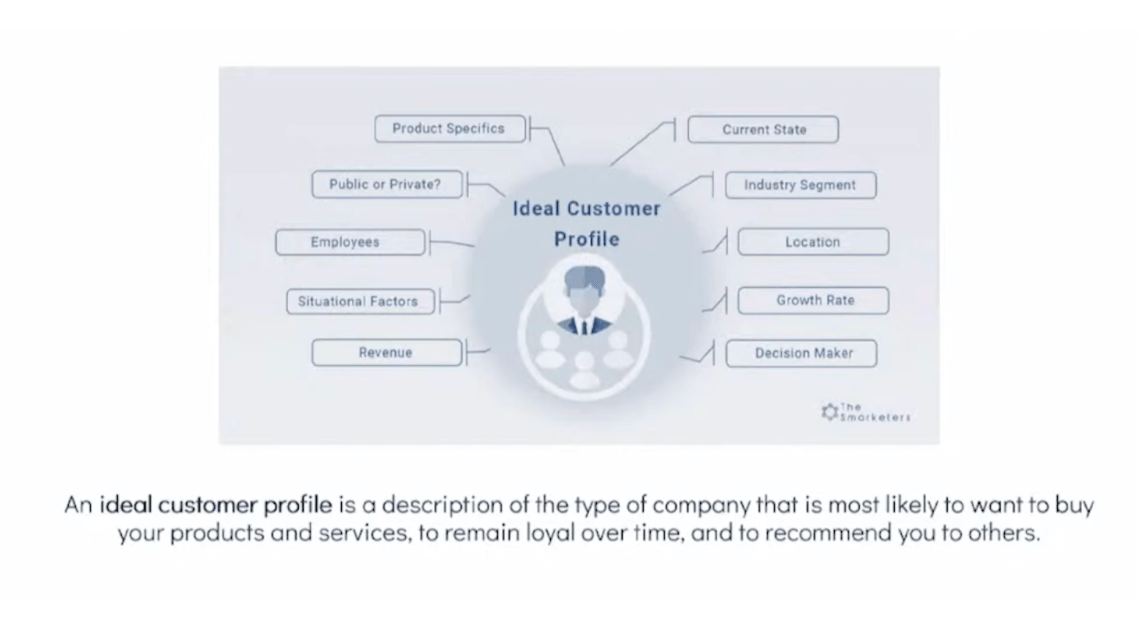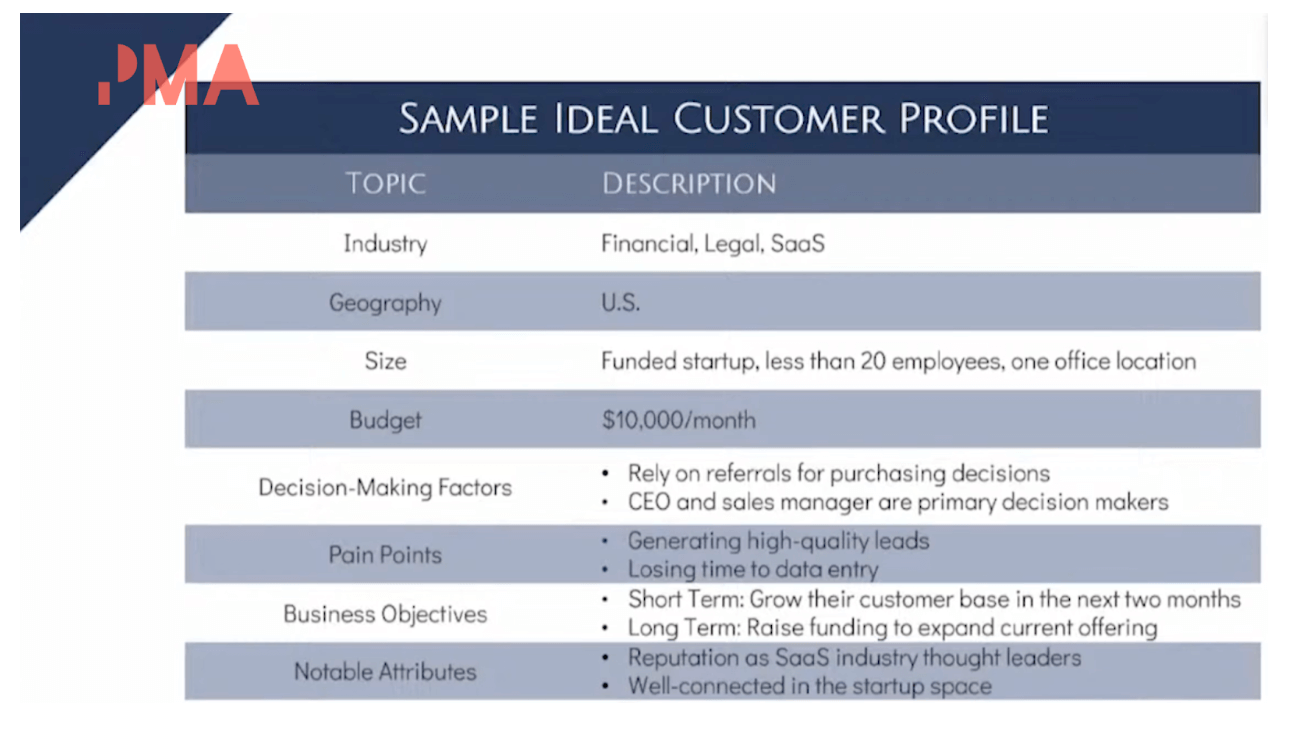As a product marketer, developing and maintaining a keen understanding of your ideal customer is essential. An ideal customer profile (ICP) acts as your north star, guiding strategic decisions from pricing to positioning, making it an essential concept to understand.
In this guide, I'll provide a step-by-step framework for developing an ICP that maximizes your product's market fit. Drawing from my own experience as Director of Product Marketing at Cyxtera, I'll share tactics for segmenting your customers, identifying their pain points, and mapping their buyer journey.
With a finely honed ICP, you can craft messaging that truly resonates with your best-fit audience. You'll also gain insight to inform product roadmap priorities that solve real customer needs. Whether you're looking to better target your messaging or refine your product features, a robust ICP provides a 360-degree view of who you're optimizing for. Follow along as I detail how to build an ICP that focuses your product, and guides your go-to-market strategy.
Here’s what can you expect to learn today:
- What an ideal customer profile (ICP) is,
- How an ideal customer profile (ICP) benefits your organization,
- The difference between an ICP and a buyer persona,
- The five steps to creating your ideal customer profile, and
- What an ideal customer profile might look like.
What is an ideal customer profile?
First, what is an ideal customer profile? Well, when we say customer profile, we aren't talking about the profile of an individual customer. We're talking about a customer type – a template of a customer who is representative of a group of customers.
The customer profile is a goal-centered representation that helps your marketing and sales teams zero in on what a typical customer who matches this profile will respond to – the sales channels, the content, and the touchpoints.
The things we look at include company size, the location of the company, the growth rate, situational factors, and who the decision-makers are.

How does an ideal customer profile benefit your organization?
One of the benefits of identifying your ideal customer profile is that you can invest both your time and your marketing dollars more efficiently. More specifically, it allows you to become more customer-centric in the way you message and position your products.
It also allows you to reduce your customer acquisition costs by showing which leads to target, aligning sales and marketing, validating product-market fit, and understanding which marketing channels will yield the maximum impact. You'll be able to increase customer lifetime value by targeting customers that are likely to be happy with your product and unlikely to churn.
Finally, you will be able to build loyalty by developing true customer advocates. These are folks who will offer testimonials, product feedback, and referrals to new clients.
The difference between an ICP and a buyer persona
One of the questions I often hear from folks when we're creating an ideal customer profile is how it differs from a buyer or user persona.
Simply put, an ideal customer profile is a profile of a target company, whereas a buyer or user persona is a deep dive into the characteristics of an individual buyer or user. This is your sales Sally, your entrepreneur Eric – the kinds of personas you would build to help your organization really understand who the buyer or the user is.
We'll talk more about this in the next section when we discuss the steps to building an ideal customer profile, but it makes sense to wait until you have developed your ICP before you develop buyer or user personas.
Once you identify the ideal customer profile, the buyer and user personas will then help others around your organization better visualize and conceptualize the folks they're selling to and building for.
The five steps to creating your ideal customer profile
Now you understand what an ideal customer profile is and why you might want to develop one, let's talk about how to actually execute it. At the risk of oversimplifying, this can be done in five steps.
- Step one: Pull together the right customer data.
- Step two: Find your best current customers.
- Step three: Determine how to get more of your best customers.
- Step four: Validate and expand upon your findings.
- Step five: Align your entire organization around building and selling to a single customer.
Let's dive into each of these steps and look at how they might be done.
Step one: Pull together the right customer data
Take stock of your current customer base
The first step is about collecting the right inputs to help you better understand your current customer base. This is an important step that people sometimes forget.
If you’re not looking at the right data and your data isn't clean, a lot of the other steps won't be done correctly, so don't try to go too quickly when gathering this data; really make sure it's right.
The first thing you'll do is export the opportunity data from your CRM. This will tell you things like what type of customer sales is successfully closing with and conversely where they have struggled to make a sale. You’ll also be able to identify the customers who generate the most revenue and who stay and grow quarter over quarter.
Next, you're going to want to gut-check that all this data is accurate. This is super important. Too often, there are errors in data that can throw off an entire analysis.
Third, you will want to append account information as needed. If you are missing data on things like company size, industry, or spending with your company over time, now is the time to add this information.
There are lots of ways to do this. Some third parties offer the ability to append your data for you. Or sometimes, if you have a small number of customers, you can manually do this on your own or with the help of your sales team.
Finally, you may want to layer in additional key industry-specific information. For example, if you sell programmatic media, you might want to leverage a third party to layer in total digital spending and total programmatic spending if this is not already in your CRM.
Step two: Find your best customers
Discover those customers most likely to find significant value in your product or service
The next step is to take this data and use it to find your best customers, those who are most likely to find significant value in your product or service.
It's important to note here this is far from an exact science; “best” means something different to every company, but here are some questions you may want to ask to discover those customers most likely to find significant value in your product or service:
- Which customers are most likely to convert? When you look at your win-loss rates, where are you seeing wins?
- Where are your highest retention and renewal rates?
- Who is spending the most?
- Who is growing fast?
- Which customers are going for upsells and expansions?
- Which customers have the shortest sales cycles?
- Who are your most satisfied customers? Where are you seeing high NPS scores? Are they willing to give referrals or offer a testimonial on your website? Sometimes, even if these customers are not your highest spenders, their willingness to advocate for your brand can make them some of your best customers.
Step three: Discover your next best customers
Tap into your pattern recognition skills to find similarities
Once you find your best customers, the next step is to identify patterns among them. What characteristics do highly satisfied, low churning, and high spending customers have in common?
When you figure this out, you can ultimately build an ICP based on what you know has worked for your business. Here are some questions that will help you spot trends among your best customers:
- Do your highest-spending (or fastest-growing or most satisfied) customers come from a particular industry?
- Are there certain locations where people find your product more useful?
- Do the companies that are really invested in your product tend to be of a certain size? This could be in terms of the number of employees, revenue, or both.
- Are you doing better with established traditional firms or high-growth startups?
- Do you succeed more with B2B or B2C?
- What stage of growth are your best customers in? For example, maybe they just went public, or maybe they have a sales trigger in the midst of a merger or a growth hiring phase. If you can figure these things out, you can help your sales team target the right customer at the right time.
Step four: Validate and expand upon your findings
Talk to customers, prospects, and your customer-facing teams
You’ve developed what you believe to be a strong ICP based purely on quantitative data. Now it's time for further conversations to validate this profile and augment it with some qualitative data. You’ll want to talk to customers, prospects, and your customer-facing teams.
First, talk to the customers in your “best customers” bucket. You’ll want to learn the sales trigger for buying your product. How did they find out about you in the first place? Was it all word of mouth? Did Google Search help? What are their biggest pain points? What do they like or dislike about your product? Are there pain points that you're not yet solving?
You’ll also want to find prospects that look like your best customers. What are their relevant pain points? What are they using today to solve for them? What might they like or dislike about their current solution? Have they heard about the solution you offer? Is there anything that might make them open to using it?
Finally, you’ll want to talk to your customer-facing teams: sales, customer success, and account management. To what extent does what you’ve learned about your best customers validate what they're seeing in the market? Are they truly finding this type of customer easy to close? Is there anything they would add or change?
The data can tell a great story, but sometimes it's different from what your sales team is seeing. In those cases, you want to go back and reevaluate your ICP.
Step five: Focus on alignment
Unite the entire organization around a single customer profile.
Once you've validated your ideal customer profile and you feel good about it, it’s time to focus on organizational alignment. The goal is to unite the entire organization around a single customer profile.
This involves first building consensus. You'll want to meet with all relevant leadership and stakeholders in small groups. The goal is to make sure everyone understands the ICP and sees it as accurate.
Next, you'll want to develop personas. You'll break down your ICP into several user personas or buyer personas to help the broader organization understand the customer, going beyond the company to someone they can visualize and conceptualize.
Third, you will want to generate enthusiasm. This means presenting your ICP to the entire company, or maybe a subset of the company, depending on its size. Hang posters of user and buyer personas everywhere.
In some companies, I've even seen them in the bathroom. This helps internal folks to conceptualize a customer. When they keep seeing it, it gets into their heads, so they know who they're building for and who they're selling to.
Finally, once you've generated enthusiasm and built a consensus, it's time to develop a plan to execute. You'll be working with cross-functional teams – maybe sales, marketing, product, and customer success – to align roles and responsibilities. This helps align sales and marketing in a way that unifies the entire customer journey.
This can also help product and customer success to deliver a consistent experience across the journey. Maybe the product needs some tweaks. Maybe customer success has touchpoints where the best customer is getting lost. The goal is to deliver a consistent experience across the customer journey so that your best customers always have the best possible experience.
What does an ideal customer profile look like?
Now that we’ve talked through all the steps, I want to share a sample ideal customer profile.
This is based on quantitative and qualitative analysis of current customers, as well as those future customers that look like them. It’s important to note that these are sample categories, and other organizations may have different relevant areas.

In this sample, we looked first at industry. For example, you might find that you are most appealing to customers from the financial, legal, and SaaS segments.
Next, we have geography. Maybe you're completely global or serve all of North America or just the Western US. Even if you serve all of America, perhaps for some reason people in the Northeast tend to gravitate toward what you have to offer. If so, that's worth exploring.
You'll also look at the size of companies that are interested in your business and show up as your best customers. Size can include revenue, locations, and the number of employees; it could also include all three.
You'll want to think through an expected budget for your product based on how similar customers spend today. If you know that your best customers typically spend around $10,000 per month on your product, that might be the budget you would look at.
Another thing you'll explore is how buying decisions are made and who makes them. For example, the buying decision might be made based on the need for referrals and the fact that they haven't found an easy way to do that in-house.
You might also learn that the CEO and sales manager are often the primary decision-makers. This can help a lot when you think about what channels you want to use and the kind of collateral you want to create.
Finally, you're going to want to look at things like pain points that might trigger a need to buy, such as the need for high-quality leads, or time lost to data entry. You’ll want to consider business objectives both in the short and the long term.
Finally, think about notable attributes. Is there anything special you noticed about your best customers that weren't covered here? Maybe they have a really strong reputation in the startup community. That's something you can look for and use as the basis for a target list, which will give your account-based marketing efforts a boost.
With that, I’ll close this article and wish you luck creating an ideal customer profile that takes your business to the next level.


















 Follow us on LinkedIn
Follow us on LinkedIn




.svg)
Start the conversation
Become a member of Product Marketing Alliance to start commenting.
Sign up now